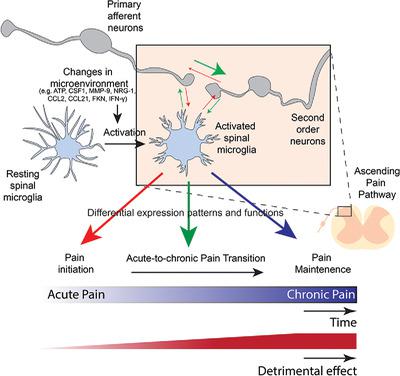当前位置:
X-MOL 学术
›
J. Leukoc. Biol.
›
论文详情
Our official English website, www.x-mol.net, welcomes your
feedback! (Note: you will need to create a separate account there.)
Spinal microglia-neuron interactions in chronic pain.
Journal of Leukocyte Biology ( IF 3.6 ) Pub Date : 2020-06-23 , DOI: 10.1002/jlb.3mr0520-695r Idy H T Ho 1, 2 , Matthew T V Chan 1, 2 , William K K Wu 1, 2, 3 , Xiaodong Liu 1, 2
Journal of Leukocyte Biology ( IF 3.6 ) Pub Date : 2020-06-23 , DOI: 10.1002/jlb.3mr0520-695r Idy H T Ho 1, 2 , Matthew T V Chan 1, 2 , William K K Wu 1, 2, 3 , Xiaodong Liu 1, 2
Affiliation

|
Current deficiency in our understanding of acute‐to‐chronic pain transition remains a hurdle for developing effective treatments against chronic pain. Whereas neurocentric mechanisms alone are insufficient to provide satisfactory explanation for such transition, neuro‐immune crosstalk has attracted attention in recent pain research. In contrast to brain microglia, spinal microglia are activated immediately in various pain states. The fast‐responsive enrichment and activation of spinal microglia among different pain conditions have highlighted the crucial role of neuroinflammation caused by microglia‐neuron crosstalk in pain initiation. Recent studies have revealed spinal microglia‐neuron interactions are also involved in chronic pain maintenance, albeit, with different anatomic distribution, cellular and molecular mechanisms, and biologic functions. Delineating the exact temporal discrepancies of spinal microglia distribution and functions along acute‐to‐chronic pain transition may provide additional mechanistic insights for drug development to prevent deterioration of acute pain into the chronic state. This narrative review summerizes the longitudinal alterations of spinal microglia‐neuron interactions in the initiation of pain hypersensitivity, acute‐to‐chronic pain progression, and chronic pain maintenance, followed by an overview of current clinical translation of preclinical studies on spinal microglia. This review highlights the crucial role of the interaction between spinal microglia and neighboring neurons in the initiation and maintenance of pain hypersensitivity, in relation to the release of cytokines, chemokines, and neuroactive substances, as well as the modulation of synaptic plasticity. Further exploration of the uncharted functions of spinal microglia‐neuron crosstalk may lead to the design of novel drugs for preventing acute‐to‐chronic pain transition.
中文翻译:

慢性疼痛中的脊髓小胶质细胞-神经元相互作用。
目前,我们对急性至慢性疼痛过渡的了解仍然是开发针对慢性疼痛的有效疗法的障碍。尽管仅神经中心机制不足以为这种转变提供令人满意的解释,但神经免疫串扰已引起近期疼痛研究的关注。与脑小胶质细胞相反,脊髓小胶质细胞在各种疼痛状态下会立即被激活。在不同的疼痛情况下,脊髓小胶质细胞的快速响应富集和激活突显了小胶质细胞-神经元串扰引起的神经炎症在疼痛发作中的关键作用。最近的研究表明,脊髓小胶质细胞与神经元的相互作用也参与了慢性疼痛的维持,尽管解剖结构,细胞和分子机制不同,和生物学功能。描绘沿急性至慢性疼痛转变的脊柱小胶质细胞分布和功能的确切时间差异,可为药物开发提供更多的机制见解,以防止急性疼痛恶化为慢性状态。这篇叙述性综述总结了在疼痛超敏反应,急性至慢性疼痛进展以及慢性疼痛维持中脊柱小胶质细胞与神经元相互作用的纵向变化,然后概述了脊柱小胶质细胞的临床前研究的当前临床翻译。这篇评论强调了脊髓小胶质细胞与邻近神经元之间的相互作用在疼痛超敏反应的引发和维持中的关键作用,与细胞因子,趋化因子和神经活性物质的释放有关,以及调节突触可塑性。进一步探索脊髓小胶质细胞-神经元串扰的未知功能可能会导致设计用于预防急性至慢性疼痛转变的新药。
更新日期:2020-06-23
中文翻译:

慢性疼痛中的脊髓小胶质细胞-神经元相互作用。
目前,我们对急性至慢性疼痛过渡的了解仍然是开发针对慢性疼痛的有效疗法的障碍。尽管仅神经中心机制不足以为这种转变提供令人满意的解释,但神经免疫串扰已引起近期疼痛研究的关注。与脑小胶质细胞相反,脊髓小胶质细胞在各种疼痛状态下会立即被激活。在不同的疼痛情况下,脊髓小胶质细胞的快速响应富集和激活突显了小胶质细胞-神经元串扰引起的神经炎症在疼痛发作中的关键作用。最近的研究表明,脊髓小胶质细胞与神经元的相互作用也参与了慢性疼痛的维持,尽管解剖结构,细胞和分子机制不同,和生物学功能。描绘沿急性至慢性疼痛转变的脊柱小胶质细胞分布和功能的确切时间差异,可为药物开发提供更多的机制见解,以防止急性疼痛恶化为慢性状态。这篇叙述性综述总结了在疼痛超敏反应,急性至慢性疼痛进展以及慢性疼痛维持中脊柱小胶质细胞与神经元相互作用的纵向变化,然后概述了脊柱小胶质细胞的临床前研究的当前临床翻译。这篇评论强调了脊髓小胶质细胞与邻近神经元之间的相互作用在疼痛超敏反应的引发和维持中的关键作用,与细胞因子,趋化因子和神经活性物质的释放有关,以及调节突触可塑性。进一步探索脊髓小胶质细胞-神经元串扰的未知功能可能会导致设计用于预防急性至慢性疼痛转变的新药。











































 京公网安备 11010802027423号
京公网安备 11010802027423号